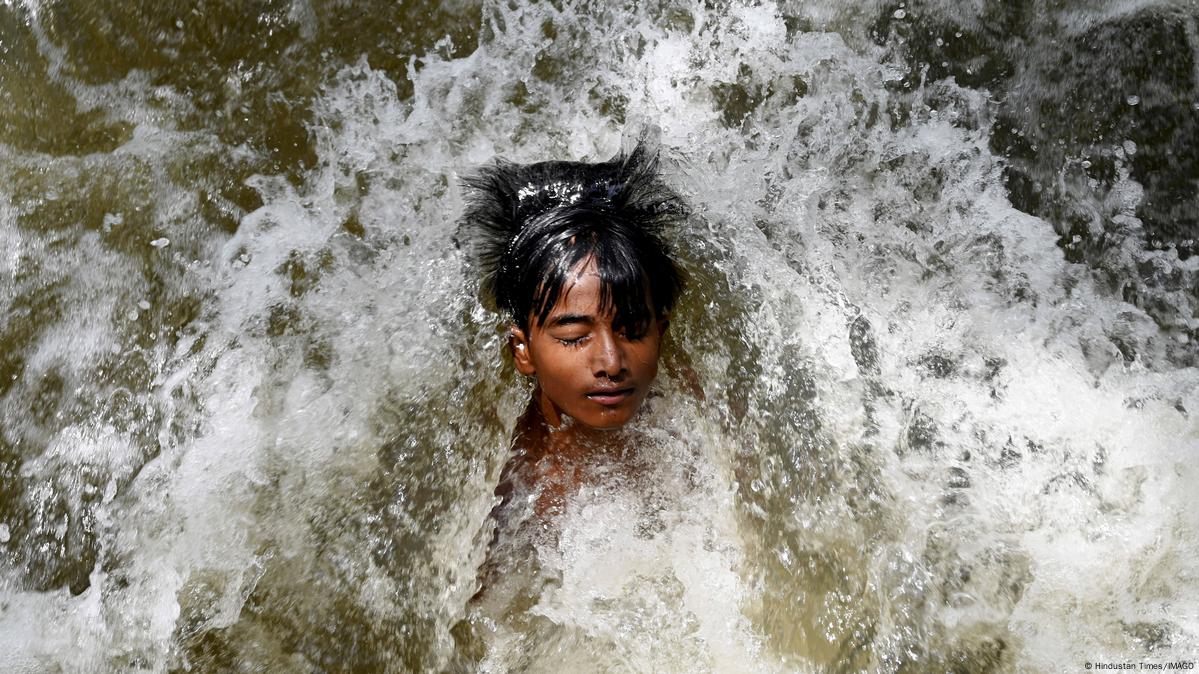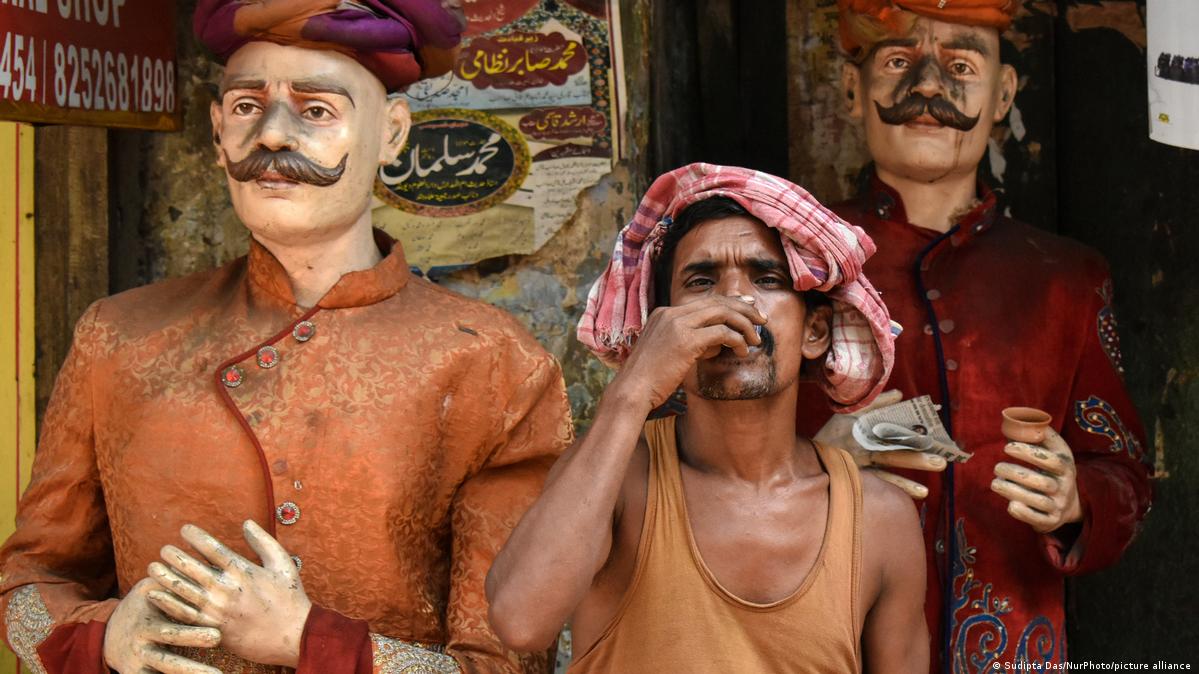Murali Krishnan in New Delhi
Torrential rains have caused flash floods and landslides in parts of India, causing death and destruction. The heavy rain comes after an unbearable heat wave.
Intense monsoon rains have lashed parts of northern India over the past few days, leaving a trail of death and destruction, as well as rendering many areas inaccessible.
The state of Himachal Pradesh has been the hardest hit.
Television footage showed landslides and flash floods, washing away vehicles, destroying buildings and ripping down bridges.
India's meteorological department (IMD) said that torrential rains across the South Asian country in the first week of July have already produced about 2% more rainfall than normal.
The agency has forecast more rain across large parts of northern India in the coming days.
"The region, which is usually one of the driest, has received disproportionately high rains," an IMD official told DW.
Climate change and environmental catastrophes
The summer, or southwest, monsoon brings India around 70% of its annual rainfall.
It is crucial for the nation's agriculture, which accounts for just 11% of India's total economic output, but employs over 40% of its labor force.
The rains also often cause widespread devastation and death due to flooding and landslides.
Scientists say the rainfall is hard to forecast and varies considerably, but climate change is making the monsoon stronger and more erratic, increasing the frequency and ferocity of the floods.
"Human-induced climate change is already intensifying hydrological extremes in India, and the recent floods in parts of northern India are yet another example of how extreme events can be more disastrous in hilly regions than in plains," Akshay Deoras, a research scientist at the UK's National Centre for Atmospheric Science and the Department of Meteorology, told DW.
Deoras pointed out that extreme weather events are set to intensify as the planet continues to become warmer due to growing emissions of greenhouse gases.
"This does not necessarily mean that high-impact events would occur every year, but whenever they occur, there would be a greater chance of them being more impactful than previous such events," he added.
How many extreme weather events last year?
Last year, the Center for Science and Environment (CSE), a New Delhi-based public interest research and advocacy organization, tracked extreme weather events in India.
It found out that the country, on the whole, experienced extreme weather events on 314 out of the 365 days, meaning that at least one extreme weather event was reported in some part of India on each of these days.
The report concluded that these events caused over 3,000 deaths in 2022, affected some 2 million hectares of crop area, killed more than 69,000 livestock and destroyed around 420,000 houses.
The UN Intergovernmental Panel on Climate Change (IPCC) also released a report last year painting a bleak picture for India.
It warned that the country could face multiple climate change-induced disasters in the next two decades.
Unless greenhouse gas emissions are drastically reduced by 2030, it will become impossible for Indian authorities to reverse an imminent climate catastrophe, it said.
Summer heat breaks records across South Asia
"Climate change is accelerating at a fast pace, throwing off extreme weather events one after the other. This is faster than what we thought earlier," said Roxy Mathew Koll, a climate scientist at the Indian Institute of Tropical Meteorology in Pune.
"South Asia has become the poster child of climate change. The entire region, not just India, is witnessing a clear trend in rising heatwaves, floods, landslides, droughts, and cyclones. This is already affecting the food, water, and energy security of the region," Koll told DW.
The heavy rains come after a blistering heat wave that caused temperatures to soar to as high as 45 degrees Celsius (113 degrees Fahrenheit) in large parts of the country, taking a toll on people's lives.
Even though the main summer months — from April to June — are always hot in India, temperatures have become more intense in the past decad
India swelters under deadly heat wave
Temperatures of up to 46 degrees Celsius (114.8 degrees Fahrenheit) are being measured in northern India. While people are trying their best to beat the heat, authorities say that at least 170 have died.Image: Hindustan Times/IMAGO

Boiling hot Kolkata
Scorching heat in summer is not uncommon in northern India, but the current temperatures of up to 46 degrees Celsius are breaking all records. In Kolkata, a man is seen here trying to cool off in the shade at the side of the road. Further northwest, the states of Bihar and Uttar Pradesh have reported 170 deaths, and hospitals are complaining about overcrowding and a lack of care
.Image: Sudipta Das/NurPhoto/picture alliance

Elderly people in distress
The sweltering heat is especially hard on older people. Lack of fluids and heat accumulation lead to serious health problems. "We have already issued heat warnings several times," said Atul Kumar Singh of the country's Meteorological Department. But government officials only followed up with heat warnings of their own on Sunday, when the number of heat-related deaths was already rising.
Chaos in hospitals
In Ballia district, about 250 kilometres (155 miles) east of New Delhi, the largest hospital reported that it can no longer treat any more patients. Nevertheless, many people waited in the heat to be registered. But the problems are manifold: Staff are exhausted, air conditioners are failing along with the electricity, nurses have to fan the overheated patients with books to cool them down
Mourning relatives
Capacities of the crematoria in Ballia district were overwhelmed with the rapidly increasing number of deaths. The situation had worsened drastically in the past week, with the number of dead being brought to some crematoria even doubling.
No respite in sight
The heat also causes stress for animals and has a negative impact on their health and milk production in cows. Climate experts expect the weather extremes to continue in India. "Plans to deal with heat waves are important to minimise their impact," said Aditya Valiathan Pillai of the Indian Centre for Policy Research.
Thirsting to cool down
Flora and fauna are also suffering from the enormous heat. A thirsty monkey in New Delhi is seen here licking up life-saving liquid in a puddle of buttermilk on the Noida road. The cooling rains of the monsoon do not reach northern India until July, and high temperatures are expected to continue until then.Image: Hindustan Times/IMAGO
Extreme temperatures across Asia
The current heat wave is not only affecting India, but large parts of Asia. Korean weather authorities issued warnings for Seoul and the eastern province of Gyeonggi at the weekend. Extreme temperatures have also been reported in Bangladesh and China
And around 80% of the population also live in regions highly vulnerable to extreme disasters like heat waves or severe flooding.
What needs to be done?
As part of India's efforts to tackle global climate change, Prime Minister Narendra Modi's administration has vowed to cut the nation's greenhouse gas emissions to net zero by 2070.
But against the backdrop of increasing extreme weather events, experts say the government needs to also focus on adaptation measures.
"More needs to be done for climate adaptation to prevent economic losses and food insecurity," CSE director Sunita Narain said.
"We need to relearn land and water management strategies. India has much to learn, from not building habitations in flood-vulnerable areas to channeling river water instead of taming rivers within embankments that invariably break or just do not work," she told DW.
"The moot question is, how fast can we learn in a climate variable world? The answers will determine our future. The window of opportunity to deal with the crisis is closing."
Edited by: Srinivas Mazumdaru
No comments:
Post a Comment